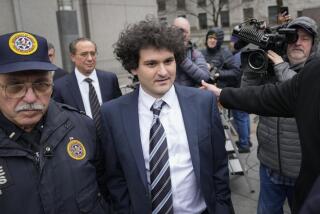Charging It to Uncle Sam : THE THRIFT DEBACLE <i> by Ned Eichler (University of California Press: $15.95; 116 pp.; 0-520-06631-6) </i>
A few years ago, when the banking industry was undergoing one of its periodic crises, a spate of television documentaries tried to capture the wheeler-dealer atmosphere that had led to so many spectacular bank failures. But explaining Byzantine financial plays to ordinary viewers wasn’t easy, as admitted by one obviously frustrated commentator. “Now pay attention,” she told the audience, waving a pointer at a spidery diagram, “because this is real complicated.”
The seeming complexities of the financial world, which are exaggerated by insiders’ jargon, have a lot to do with the public’s--and Congress’--boredom with the subject. But as pointed out by Ned Eichler in “The Thrift Debacle,” it behooves the taxpayer to pay attention because billions of dollars in tax money are being thrown down a black hole to pay for the ongoing follies of greedy gamblers and inept bank regulators. Financial experts estimate that every taxpayer will be liable for at least $1,000 in the Bush Administration’s 10-year, $126-billion bailout of the crippled savings and loan industry, and that’s just a starter: Down the road are bailouts for commercial banks that lent a large chunk of their capital to bankrupt Third World countries and a government that has consistently overspent its income.
Although Eichler’s account is densely packed with statistics, it is more readable than many books on financial matters because it deals with a single subject, the plight of S&Ls;, or thrifts in bankers’ parlance, and his argument is succinct: that the Reagan Administration made a bad situation worse through deregulation and that bank regulators went along with a game in which taxpayers’ money in the form of government insurance was used to back unsound and/or illegal loans.
A professor in economic history who has worked closely with the housing industry in California, Eichler has written extensively on house problems and served as a government adviser on the subject. While his book is a relatively balanced account of the thrifts’ rise and fall, he obviously feels thwarted by the refusal of government regulators, particularly Richard T. Pratt, to listen to his arguments against deregulation. A brash young finance professor, Pratt was Reagan’s first head of the Bank Board, which oversees the S&L; industry, and, in Eichler’s opinion, the symbol of an idea that propelled Reagan into the White House--to get the federal government “off people’s backs.” Regardless of its practical consequences, deregulation became a byword at the White House and the fashion in Congress and academia, especially among supply-siders. But as in other matters, Reagan left implementation to “men ill equipped to handle such a delicate task.” When queried as to why he never briefed the President on the severity of the S&L; crisis, reports Eichler, Pratt’s successor at the Bank Board said Reagan had no interest in such matters and that it had never occurred to him to talk to the President.
Eichler begins his sobering tale with a historical overview of S&Ls;, the function of which was to finance home construction and purchase, primarily single-family residences. Until the Great Depression, such institutions operated with little government interference, but the collapse of thousands of banks forced the Roosevelt Administration to take an active role in the system’s revival. Housing construction has traditionally been a weather vane for the economy, and Roosevelt’s government rightly viewed the reactivation of the S&L; system as a priority. Medicine was administered through federal loans to prop up the housing market and government insurance to thrifts for deposits of up to $100,000, the latter administered by the Federal Savings and Loan Insurance Corp. (FSLIC).
By 1935 a system had been put in place that would govern the S&L; industry until 1980. Though excluded from the activities of commercial banks and required to invest the majorityof their funds in home loans, the thrifts were able to outbid commercial banks for savings deposits through a government regulation that limited the interest that banks could pay for such deposits. As Eichler observes, “Had banks, whose main job was commercial lending, been able to compete equally for savings or had thrifts been free to make non-real estate loans, less money would have been available for housing.”
While the industry suffered ups and downs, depending on the state of the economy, it performed its purpose by fostering home ownership. But by the end of the 1970s that role was no longer clearly defined because commercial banks and other financial players, including large pension funds, had begun to encroach on the thrifts’ turf at the same time that the thrifts were diversifying into once forbidden territory, such as consumer lending. That they had little competence in such a field or that 15,000 commercial banks already provided such services did not deter the deregulators, who lobbied for a free-for-all in which all financial entities, S&Ls; included, would compete on the same footing.
By the time Reagan took office, legislation had already begun to phase out interest ceilings and enable S&Ls; to make commercial real estate loans, but Pratt, with congressional support, pushed deregulation further, by allowing thrifts to expand into money market accounts and business deposits and to increase commercial real estate and other loans. The aim of such measures was to prop up the S&L; industry, which was suffering from the mismatch of fixed-interest loans and growing competition from other financial institutions. But the result was disaster. Encouraged to use ingenious if questionable accounting gimmicks that disguised sick or moribund thrifts, go-go financiers were able to borrow 30 times their institutions’ capital by offering a government guarantee in the form of insured savings deposits.
As Eichler points out, the arrangement was like a blank check: S&L; managers and shareholders received all the profits, while the government was responsible for losses because of deposit insurance. Fortune hunters quickly realized the potential for gain, snapping up S&L; charters for as little as $1 million. Thrifts, particularly in California, created “disguised loans,” by financing real estate ventures that they themselves initiated. Some managers and owners engaged in self-dealing by moving money from the institution into their own pockets.
Losses skyrocketed, and by the end of 1986 the FSLIC insurance fund was exhausted. Healthy thrifts found themselves sucked into the vortex because they were forced to contribute higher fees to keep the FSLIC afloat. Even Pratt recognized that the situation had become untenable, but neither he nor his successors clamped down on the industry.
Eichler argues that the Bank Board should have stopped issuing new charters, instituted tough accounting reforms and forced thrifts to reduce lending and increase capital ratios. Instead of bailing out bankrupt institutions, he says, the regulators should have let them fail because the bill to the Treasury would have been much less than current and future bailouts--Eichler estimates that one-quarter of the country’s 4,600 thrifts are so sick that they are unlikely to survive.
Although his formula makes economic sense, it is politically unacceptable because legislators and regulators fear a public backlash. Nor are they prepared to go as far as Eichler in allowing the market for home financing to be taken over entirely by other financial entities. Indeed, if there is a weakness in his argument, it is a willingness to throw the baby out with the bathwater. The United States may not be facing a housing shortage, as he claims, but large numbers of people are unable to obtain affordable housing, a question Eichler ignores. Other experts, such as Carol O’Cleireacain, an economist with the American Federation of State, County and Municipal Employees, believe that the current bailout must get S&Ls; back to their original mission, not only through re-regulation but also through conditions for taxpayers’ money that could produce affordable mortgages. For example, instead of selling off valuable residential property at any price in order to recoup losses from the thrifts it has taken over, the FSLIC could make it available to local housing agencies and nonprofit organizations to meet urgent housing needs.
Government bailouts are not always a failure, as shown by the turn-around in the finances of Chrysler and New York City, but those that receive government aid are under an obligation to change the practices that got them into trouble in the first place. Unfortunately, as O’Cleireacain points out, there is little likelihood of such reform in the S&L; industry unless Congress forces it to accept new ground rules.
More to Read
Sign up for Essential California
The most important California stories and recommendations in your inbox every morning.
You may occasionally receive promotional content from the Los Angeles Times.










